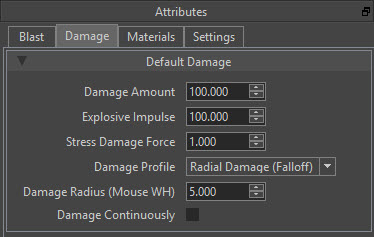Damage Tab¶
The Blast Authoring tool Damage Tab allows you to change the Damage Amount, Impulse and more to break your Blast Mesh in differnet ways. This tab’s values are active when the Damage Button is on.

Default Damage¶
- Damage Amount - The amount of damage generated per Left click or per tick if damage continuously is checked and Left Click is held. If this value is above the Material Hardness of your Blast Mesh it will break.
- Explosive Impulse - The amount of force generated per click or per tick if damage continuously is checked and Left Click is held.
- Stress Damage Force - Stress damage comes from the stress solver, which calculates internal forces both from the weight of the actors as well as forces coming from the outside. Stress Damage Force is the external force to apply, to send to the stress solver.
- Damage Profile - This dropdown give you options of the type of damage you want to apply to the mesh.
- Damage Radius (Mouse WH) - Changess the range of the damage dependent on the type of damage picked.
- Damage Continuously - Toggle true the damage will be applied per tick on Left Click hold.
Damage Profile Options¶

- Radial Damage (Falloff) - Full damage is applied up to the minimum radius, with a linear falloff to zero at the maximum radius.
- Radial Damage (Cutter) - Damage is only applied within a small distance from the surface of the damage sphere, that is, a spherical shell.
- Slice Damage - Damage is applied on a triangle (defined by its vertices). The triangle is intersected with line segments connecting chunk centroids, representing the chunk bonds. When an intersection occurs, the given damage amount is applied to the bond. This can be used to emulate a damage segment sweep, in such a way that bonds are not missed because of damage radius or frame rate.
- Capsule Damage(Falloff) - Full damage is applied up to the minimum distance from a line segment, with a linear falloff to zero at the maximum distance from the line segment.
- Impact Spread Damage - Damage is applied from collision contact events, and spreads outward along the support graph, up to a maximum distance along the graph. This is in contrast to radial damage, which will damage all chunks within the maximum radius, regardless of the length of the connected path to the chunk.
- Shear Damage - Damage has a direction associated with it, and the damage to a bond depends on the direction of the bond normal relative to the damage direction. The more perpendicular the damage direction is to the bond normal, the more damage.
- Stress Damage - The internal stress solver applies damage.